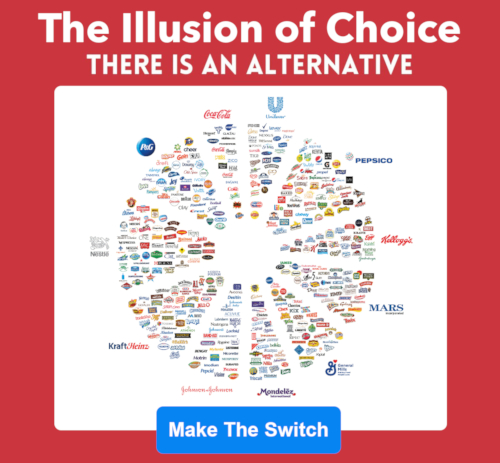The rise in consumer prices has rightly received a great deal of attention, as inflation hovers around 40-year highs. Everyone can see that virtually everything is getting more expensive, but fewer have noticed that many items are also getting smaller.
On Wednesday the Associated Press ran an article under the headline “No, you’re not imagining it — package sizes are shrinking.”
The AP spoke to one shopper, Alex Aspacher, who does a lot of shopping for his family of four in Ohio. He noticed he was still paying $9.99 for Swiss cheese even though the package had shrunk from a pound to 12 ounces.
“I was prepared for it to a degree, but there hasn’t been a limit to it so far,” Aspacher told the AP. “I hope we find that ceiling pretty soon.”
This phenomenon—known as “shrinkflation”—is nothing new, of course. It’s just more pronounced now than in any time in recent memory because inflation is much higher.
But what exactly is shrinkflation? As economist Peter Jacobsen explained last year, it’s simply a different kind of inflation.
“Shrinkflation is a form of inflation because you’d have to spend more money to get the same quantity or quality as you did in a previous year,” he explained. “The prices have remained the same, but the products are worse.”
The only difference is, instead of raising the price of an item or service, businesses are reducing the quantity or quality of it while keeping the price the same.
Edgar Dworsky, a consumer advocate who has tracked shrinkflation for decades, told the AP shrinkflation is rampant at the moment because of the underlying economic conditions.
“It comes in waves,” said Dworsky. “We happen to be in a tidal wave at the moment because of inflation.”
While there are too many examples of shrinkflation to easily track, here is a list of some examples Dworsky highlighted and others that we found.
- Kleenex: A box now has 60 tissues instead of the 65 it had a few months ago.
- Yogurt: Chobani Flips have shrunk to 4.5 ounces; they had been 5.3 ounces.
- Domino’s Pizza, citing the rise of chicken prices, announced earlier this year it was shrinking its 10-piece chicken wing package to eight pieces. The carryout price remains the same: $7.99.
- Toothpaste: Tubes of Crest reportedly have shrunk from 4.1 ounces to 3.8 ounces.
- Folgers coffee reduced its 51-ounce container to 43.5 ounces. (Oddly, Folgers still says the container will make up to 400 cups of coffee, citing a new technology that yields lighter-weight beans. Or something.)
- Fritos: “Party Size” bags used to be 18 ounces, but most retailers are now advertising 15.5 ounce bags.
- Gatorade: PepsiCo, who produces Gatorade as well as Fritos, has begun phasing out 32-ounce bottles and replacing them with 28-ounce ones, which are actually more expensive. (PepsiCo said the change was unrelated to the economic climate and the plan had been in the works for years.)
- Cereal: Honey Bunches of Oats reduced its standard cereal box to 12 ounces; it had been 14.5 ounces.
- Paper Towels: Bounty reduced its 2-ply sheet roll from 165 to 147 sections.
- Oatmeal: Quaker reduced the number of pockets in a box from 10 to 8, reports the Daily Mail.
- Ziploc bags: Boxes now come with 50 in a package instead of 54.
- Soap: Dial reduced its bottle size from 21 ounces to 16 ounces.
BONUS Item: Airline service: As FEE’s Peter Jacobsen notes, airline complaints are through the roof, the result of reduced customer service.
We could go on, of course. But you get the point.
Some people naturally want to blame companies for shrinking the size of their products while charging the same price (or higher ones), but this is the wrong reaction.
As noted above, shrinkflation is simply a form of inflation, and inflation is a monetary phenomenon above all else.
“Inflation is always and everywhere a monetary phenomenon,” noted Nobel Prize-winning economist Milton Friedman, “in the sense that it is and can be produced only by a more rapid increase in the quantity of money than in output.”
It’s no coincidence that America is experiencing the highest inflation in decades after the Federal Reserve “flooded the system with money,” as Fed Chairman Jerome Powell admitted in a 60 Minutes interview.
The mystery of Inflation.
“You flooded the system with money.”
“Yes, we did.” pic.twitter.com/2ClRf97fg7
— Jon Miltimore (@miltimore79) January 17, 2022
This was a perfect recipe for inflation.
“Inflation is caused by too much money chasing after too few goods,” Friedman noted.
You simply can’t drop $5 trillion dollars into an economy without a corresponding expansion of goods and services and not experience inflation. This is why we’re seeing it now, both through higher prices and the reduced quantity and quality of goods and services.
So if you’re upset you’re paying just as much for less cereal, toilet paper, tissue, and countless other products, that’s fine. Just make sure your anger is directed in the proper direction: at the people who “flooded the system with money,” and those who directed them to do so.t be kept.”
This article by Jon Miltimore originally appeared at FEE.org and is republished with permission. ©All rights reserved.
- Natural Immunity Offered More Protection Against Omicron Than 3 Vaccine Doses, New England Journal of Medicine Study Finds - July 18, 2022
- Yes, the Products You’re Buying Are Getting Smaller—Even Though Prices Are Not - June 18, 2022
- Biden Administration Refuses to Budge on Trump’s Steel Tariffs, Despite 40-Year High Inflation - June 18, 2022
JOIN US @NewRightNetwork on our Telegram, Twitter, Facebook Page and Groups, and other social media for instant news updates!
New Right Network depends on your support as a patriot-ran American news network. Donate now


